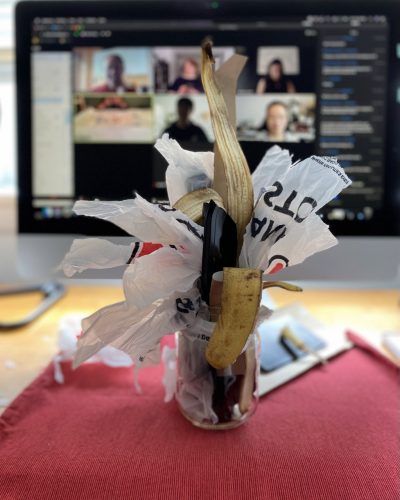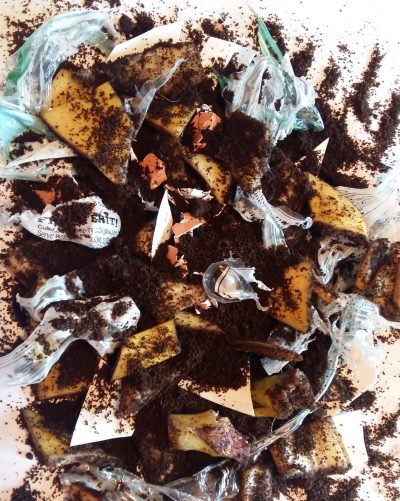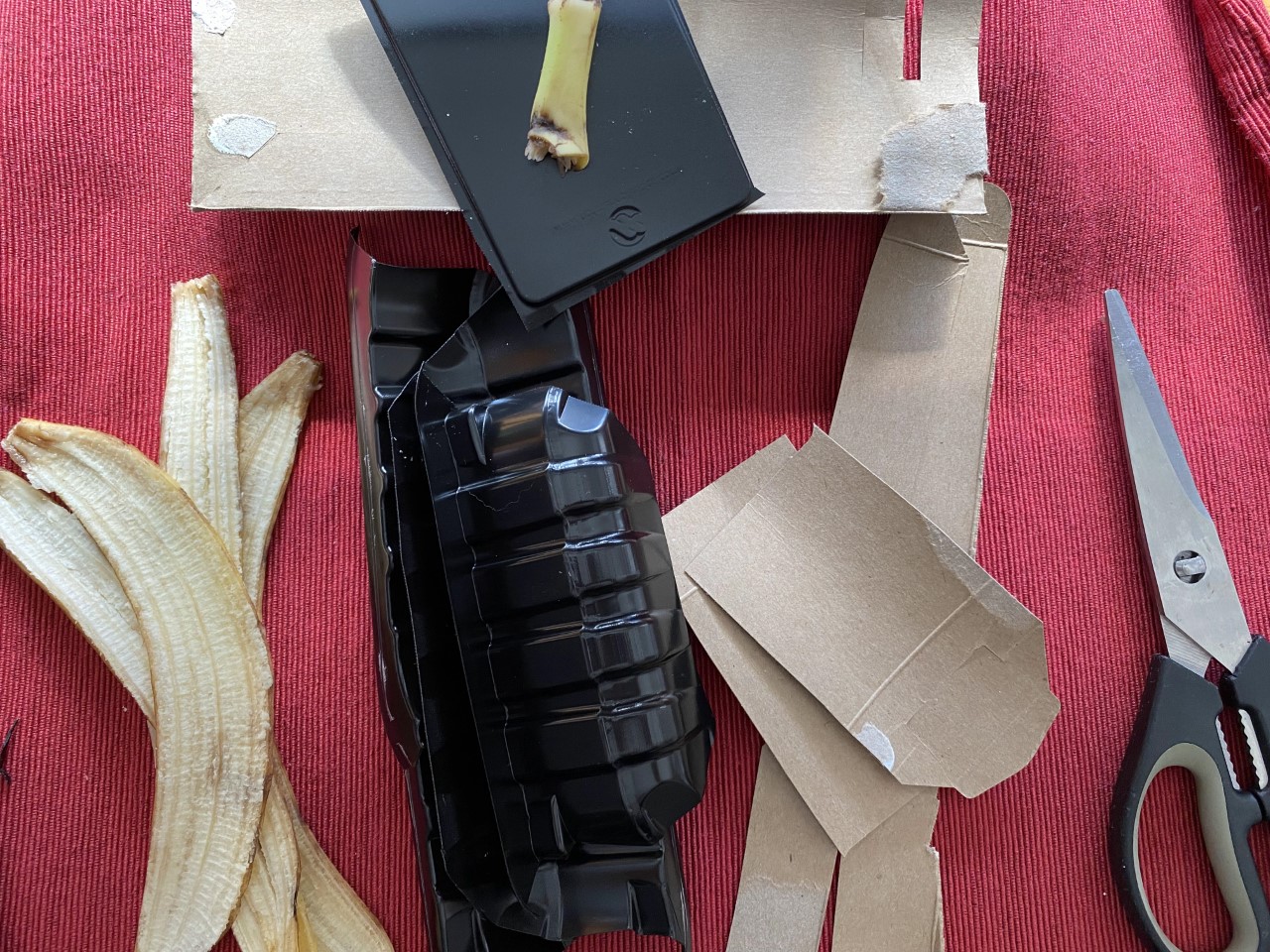By: Allison Norris
Pamela Tudge had a number of roles at the Food Matters & Materialities conference. A Ph.D. candidate at Concordia University, Tudge curated a virtual gallery exhibition centered on alternative forms of knowledge creation in contemporary food cultures and hosted an online workshop that invited participants to physically break down their household waste to reimagine their relationship to daily discards of consumer life: Everyone Makes Waste: Using Accessible Art and Design Practices to Increase the Visibility of Food-based Waste. In addition, she presented her paper, “Encounters: Re-engaging with the Materials of Food Waste”, based on her public workshop series and two projects: The Grandma Project and Eat, Make, Waste.

Credits: Allison Norris.

Credits: Myriam Durocher.
All these endeavors zero in on public pedagogy, the way the public is educated, through engagement with food waste materials. Things like wrappers, peels, napkins, cardboard, and anything someone might not usually be concerned with after it has been put in the garbage bin and hauled away. According to Tudge, managing food waste is both gendered and a form of domestic labour that has shifted since post World War II and resulted in disconnection from previous knowledges about food waste. Tudge met with me to discuss her food waste workshops and how she uses public pedagogy to care for, learn from, and make waste visible once again.
Allison Norris: In your presentation, you mentioned walking along the streets of Montreal on garbage days, which drew your attention to waste and changed the direction of your doctoral research. Can you talk a bit about The Grandma Project and Eat, Make, Waste?
Pamela Tudge: I was doing my own experiments, trying to figure out food waste through an autoethnography, documenting food practices at home. I started with the concept of women and looking at waste, cooking, and the kitchen environment. I was invited to do workshops around waste – to transform it, forming things, doing self-experiments, like Eat, Make, Waste. After about four or five workshops, I realized I wanted to interview women about this because I was looking at food waste in a very particular way, using design, coming into different environments, and relearning what these products are. I wanted to go back and start looking at: Why do I care? What shapes different practices?
The original question for my Ph.D. was around what makes certain people take action and other people just not care. Coming from my own experience with different women in my life, The Grandma Project dawned on me halfway through my doctoral work; I needed to bring that perspective into the research around waste because the interviews with the women were exceptionally interesting. As a starting point, I interviewed women I would consider mentors in my life when it comes to food. I called it The Grandma Project because I identified the grandmas of my oldest daughter, the women who were feeding her. I was curious to evaluate the difference between them. One of the things that I brought up in the presentation was that they kept talking about their childhoods and what they witnessed, which was in a different country for each of the three. Clearly, this influences them in different ways – three completely different cultural contexts in which they were learning food. They brought those basic understandings throughout their whole life. Perhaps their learning and cultural influences can help us understand pedagogy and teaching people. What am I supposed to be teaching people now? What are we supposed to be developing in these pedagogies around food? Can people tell us what they learned or how they learned it? What stayed with them and what didn’t stick with them? What can we learn from the generation that grew up during all those changes to put into the workshop?
AN: Art is also really central to this work. How does art allow you to better express your research ideas to particular audiences?
PT: I’m lucky to be in Montreal. Many of the food researchers at Concordia are in the fine arts department. My colleagues researching food have an arts perspective, and I came from social sciences. The way things are contextualized at Concordia, the research-creation ideas, my supervisor happens to be in design – I was very much influenced by the difference in thinking through materials, the creation of an artifact as a way of brainstorming, letting go of the logical, rational way of researching. What can I do with the materials in my house? All the garbage in the recycling? The compost I’m collecting for the non-composting system? What do I do with this stuff? I was happy to be freed of the logical way of approaching waste and come up with different ways of approaching it. The whole idea is to switch the narrative around waste.
Canada is the biggest waste producer in the world – we produce this much garbage, this many times, this is the way it’s managed. What do you do with that information? I want to intervene in a different way for myself and for other people. We’re not trying to understand from a strictly waste management perspective. We’re trying to learn about the material.
My ideas came from playing with materials, creating the collages, coming up with printing ideas, and my memories around working with community artists. In Victoria, I have a good friend that does work with invasive species. She takes invasive species out of a landscape and weaves baskets with them. She does this with people because she’s a community artist. I thought that’s amazing!
I worked with an established community artist on the west coast. One day she asked me to make potato prints with her. She had gathered a bunch of potatoes from her farm, set up a table, and started asking people to create potato prints. And people did. They were fascinated because we all know how to potato print from being a kid – it’s an easy art exercise. They were, of course, talking about potatoes. That was the whole point; it was International Potato Year, so she wanted to talk about potatoes. She did it all day long. People talked about potatoes and she hung the potato print posters around campus. Everybody engaged in the conversation and was aware, at least for that short period of time, about potatoes. It was very much an embodied process. Nobody felt scared to do a potato print – she wasn’t asking anybody to do something that they were uncomfortable doing as an art practice. It was fun to do that for the day because it was accessible: art practice, talk about something, and it worked.
When I started doing the workshops, I got people to make one little thing in a public space. That became the longer Eat, Make, Waste workshops.
AN: How is this outreach important to the work and research that you’re doing?
PT: My definition of public pedagogy is learning outside of the classroom in different environments, not in an academic institution or classroom. For community-driven issues like food waste and food-based waste, public pedagogy becomes an interesting model that I’ve married with critical design. More than theoretical, it is a form of design around critical research, although I’m not creating big elaborate installations. My idea is to take the concepts of critical design and marry it with public pedagogy to make the ideas, the discussions, the conversations as accessible as possible. I want something that we can all access.
An issue with critical design is critical designers might use complicated ways of building designs and making large scale installations. The accessibility of those is limited because they tend to be part of design fairs and within a gallery space. A gallery space can be considered similar to a classroom space but for specific audiences and not necessarily public or accessible.
Most conversations in the workshops are open, everybody can contribute, keep the conversation going, and we can take out academic language. This is a community problem. It’s a volunteer effort. We need to keep it interesting. By marrying critical design and public pedagogy, I make ideas and processes around critical design accessible for everybody to participate. In that way, hopefully, I make things like food-based waste and food waste more interesting to engage with and notice.
AN: I remember participating in the workshop for the conference. After making a bouquet of banana peel and takeout container strips, I had an affective response, which got me thinking differently and brought up a lot of questions. What kind of responses do you get from these workshops? What do you want people to take away from this research?
PT: Early on, I determined I don’t want to say, ‘we’re trying to create solutions’ or ‘we’re going to come up with a policy plan’. Part of the accessibility is to say, ‘this isn’t a solution, but we’re trying to work with the materials and look at this issue’. The workshop is not to make or design a solution. Participants are, however, intervening and engaging with waste in a specific way – that is important to say about the workshops.
Many reactions come up during the conversations in workshops – anecdotes about the materials, people, being upset about the world, the state of climate change, the environment, and feelings of powerlessness. But we have to engage with these feelings, reactions, and the waste to be able to lobby the corporations, the industry, and the governments to make change. If we don’t see the waste, we’re not going to engage with the policy discussions. That’s the intervention of the workshops – the more we engage with waste in ways that are accessible, the more people think, are interested, and engage with policy discussions.

Credits: Allison Norris.
My thanks to Pamela Tudge for her time. She plans to continue to discuss food practices and waste practices via The Grandma Project while including more projects onto her public pedagogy model and continuing her outreach workshops. For more information, visit pamelatudge.com.
This interview has been edited for length and clarity.